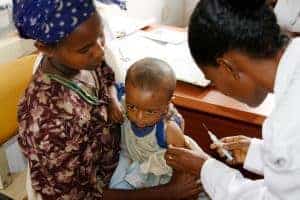Final phase 3 trial results of a malaria vaccine designed to knock down the high burden of disease in African children showed that it can prevent a substantial number of infections, but the length of protection wasn’t as long as hoped.
Greater benefits were seen in young children 5 to 17 months old than in infants, and a booster dose of the RTS,S vaccine given 18 months later prolonged protection in both groups. As the next step, drug regulators and global health officials will now weigh if the vaccine—the world’s first for malaria—should play a role in battling the disease.
An international team called the RTS,S Clinical Trial Partnership published its findings yesterday inThe Lancet.
Years of clinical trials
The vaccine has been in clinical trials since 1992, and the phase 3 study has involved more than 15,000 children at 11 centers in 7 African countries. The RTS, S malaria candidate vaccine contains an AS01 adjuvant and is given in three doses.
Initial phase 3 results in 2011 had suggested that at the 1-year mark, the vaccine halved cases in children ages 5 to 17 months, and the early findings in babies ages 6 to 12 weeks found a more modest benefit for infants.
The studies have been funded by the vaccine’s maker, GlaxoSmithKline (GSK) and the Program for Appropriate Technology in Health (PATH) Malaria Vaccine Initiative.
A 2014 study assessing the vaccine’s performance after 18 months showed a vaccine efficacy of about 46% in the older age-group and 27% in infants.
Booster dose helped
The new study was designed to show how the vaccine performed over the next 20 to 30 months and whether a fourth booster dose had an impact on protection. Participants received three doses of RTS,S with or without a booster dose, with older children in the control group receiving the rabies vaccine and younger controls getting a meningococcal vaccine.
Researchers found that at the 4-year mark for children in the older age-group who got three doses of vaccine plus a booster, the vaccine reduced clinical malaria infections by 36%, down from the 50% efficacy seen the first year.
When the team looked at the vaccine’s impact against severe malaria, they found no significant efficacy among those who didn’t receive a booster dose. For youngsters who got the booster dose, efficacy against the severe form of the disease was 32%, with 35% efficacy against malaria-linked hospitalization.
For the infant group, the ones who received the three doses, plus the booster dose, showed a 26% reduced risk of malaria, but the research team found no significant protection against severe disease.
Meningitis infections were more frequent in children who received the malaria vaccine, and kids immunized with RTS,S had more adverse reactions. Convulsions after vaccination, though rare, occurred more often in malaria vaccine recipients than in controls.
Brian Greenwood, MD, a study author and professor at the London School of Hygiene and Tropical Medicine, said in a Lancet press release that despite the efficacy drop-off, the vaccine is still poised to prevent millions of malaria infections in kids in high burden countries.
He added that the European Medicines Agency will now assess the vaccine based on the final data, and if the opinion of its experts is favorable, the World Health Organization (WHO) could recommend the vaccine as early as October.
Duration of protection spotlighted
In a commentary in the same Lancet issue, two vaccine experts from the WHO, Vasee Moorthy, MD, PhD, and Jean-Marie Okwo-Bele, MD, MPH, congratulated the authors on the quality of the study and said industry involvement in the vaccine’s development has been crucial.
They said two WHO advisory groups will consider whether to recommend that the vaccine be added to the vaccine schedule for children in Africa. The committees include the Strategic Advisory Group of Experts on Immunization (SAGE) and the Malaria Policy Advisory Committee.
One key question is likely to be duration of protection, the two wrote. “Unlike many illnesses of infancy, the risk of death from malaria continues through early childhood, even in the face of repeated infection, although the mortality rate drops from the age of 2 years in high-transmission settings.”
They noted that, if the vaccine is recommended, the donor community would need to coordinate funding for the vaccine carefully to avoid directing resources away from other measures such as treatments, diagnostic tests, and prevention tools.


